Keyword-targeted content marketing for marketplaces
In the previous article of this series on marketplace SEO, you learned about doing keyword research for your marketplace. Now it’s time to put those keywords to work.
Published on
Last updated on
“The art of SEO is writing natural copy with an SEO mindset,” says Michael Caldwell, founder of the marketplaces Gigmasters (now The Bash) and Petworks.
“Some experts say, ‘don’t even think about SEO, just write for humans.’ And then there are people who do every SEO trick in the book. We always try to find the right balance. Never use tricks but keep SEO in mind in everything you do.”
Striking that perfect balance, however, can be difficult. This fifth article in our marketplace SEO guide looks at some examples of how marketplaces can use keywords effectively while creating user-friendly content. I’ll share examples from existing, well-known marketplaces and lean on expert advice from Michael Caldwell, Mike van der Heijden, founder of the marketplace SEO agency Portal Ventures, and Gregory Edwards, SEO Manager at UK’s largest SEO agency BlueArray.
After doing keyword research for your marketplace, you have a list of prioritized keywords to target. Now, you should identify what to do with them.
As a first step, Gregory Edwards recommends looking at the content that currently ranks for your keywords.
“Review the SERP [search results page] landscape for the keywords you’re trying to target. Understand what the top performers are doing well in terms of format, headings, and keywords. What is the type of content that appears in the search results?”
Analyzing the SERPs helps you get a deeper understanding of the search intent. If the top 5 results for a keyword are long-form blog posts or how-to guides, it’s unlikely your commercial category will rank no matter how well you optimize it.
Looking at the competition also helps you understand the quality criteria for ranking. To get your page to the top, you need to offer something better than what currently ranks.
“In your content strategy, focus on quality over quantity,” Gregory says.
“Low-quality content is a common issue on marketplaces. You don’t want additional low-quality pages appearing on your blog section.”
Does a competitor’s category page rank first? Build an even better page with a higher-quality supply and some relevant content on how to choose the best provider, for example.
Is the ranking article a review of the top 15 services or products? Write better reviews for the top 20.
In a nutshell: understand the intent and serve it better than others.
A general rule for optimizing any website is tying one keyword (and its close variants) to one specific page.
You can make a plan for them in the same spreadsheet you created when you started your keyword research project. List your marketplace’s top pages that you want to drive traffic to and the keyword that works best for each page. Some keywords on your list might need completely new pages. I’ll discuss creating landing pages and blog content later in this article.
Whatever you do, don’t try to optimize two different pages for the same or very similar keyword. This may lead to keyword cannibalization. It’s a phenomenon where Google isn’t sure which page you want to rank for. As a result, neither of your pages performs as well as they could.
Dedicating one page to one topic is friendly to your users as well, as they’ll be able to find the information they’re looking for easily.
If you’re planning to invest heavily in SEO and create lots of new articles, you can already start thinking about topic clusters for your marketplace. Topic clusters are a way to structure content around topics: first, you create a “pillar page” for the main topic and then create cluster pages for more in-depth discussions of specific questions around it.
Clustering content is a great way to avoid cannibalization and make the most of your content’s ranking power. Here’s a great article on topic clusters by Semrush.
Meta tags give search engines more information about your pages. From the perspective of using keywords efficiently, the most important tags are your title and description tags.
Title and description tags help search engines understand what your page is about, but their most important job is to be an advertisement for your page on the search results page. They are your chance to convince searchers to visit your site.
Here’s a great example of a compelling SERP result from the real-estate marketplace Zillow. I searched for “homes for sale portland”, and Zillow’s title tag convinces me that their page will answer my search intent perfectly. First of all, there are many over 2,000 homes to choose from, which is great. And I’ll also get powerful tools to filter the results and find the perfect home for me. Click!

Note that Zillow also uses structured data to enhance its SERP presence: the breadcrumbs schema shows the site hierarchy, and the event schema lets Zillow add some upcoming Open House events. You can learn more about using structured data in the article about technical SEO for marketplaces.
Here are the best practices for great title and description tags.
- Add a unique title to every page of your marketplace. Don’t create duplicate titles.
- Don’t forget the listing and profile pages! In Sharetribe’s products, you get tools to define the meta tags of your user-generated pages with variables so that these pages have unique titles and descriptions too.
- Keep the length to under about 60 characters, including spaces.
- Remember search intent.
- Use your main keywords in the title.
- Make the title readable and genuinely engaging. Don’t stuff it with keywords, and don’t give in to using clickbait.
- Add a unique description to every page, including user-generated pages. Avoid duplicate descriptions.
- Keep the length to under about 160 characters, including spaces.
- Create a compelling summary of the content of your page.
- Assure searchers your page matches their search intent.
- Use keywords naturally. Leave them out if adding them feels like stuffing.
Google may override your tags with content they feel matches the search intent better, but writing high-quality tags yourself remains important. According to Google, site-defined meta tags are still used around 80% of the time.
Meta tags are also quite fun to experiment with. Write your current title and description tags in a spreadsheet and pull the current data on position, impressions, clicks, and click-through rate (CTR) from Google Search Console. Make an adjustment to a tag, document it in the sheet, and monitor the situation for a couple of weeks. Do you see a consistent change in the CTR?
You can find lots of tips and inspiration online for writing the perfect tags. For example, check out Ahrefs’ thorough article on crafting the perfect SEO title tag and Search Engine Journal’s guide to meta descriptions.
Your marketplace category pages are a great opportunity to rank for relevant, transactional keywords. But there is bound to be competition for these keywords, so you’ll need to optimize your pages carefully. In addition to technical SEO, optimizing your content and keywords is crucial.
“Every time you launch a new category within a marketplace, there’s a learning curve where you become a mini expert in that particular category,” Michael Caldwell says.
By becoming an expert, Michael means doing your keyword research properly for every category, finding the main keywords and variants your audience uses, and incorporating them into the content.
First, make sure that your category name and H1 titles feature the primary keyword you’re targeting. Before choosing the main keyword, ensure you’ve looked into all alternatives and selected the one your audience uses the most.
Second, incorporate the variants and alternative keywords that belong to the category in the body copy and subheadings. See how Petworks uses “Dog trainers” as the H1 of its category page and features other keywords like “animal behaviorists”, “puppy training”, and so on elsewhere in the page content. The page also refers back to the main “pet training” category.
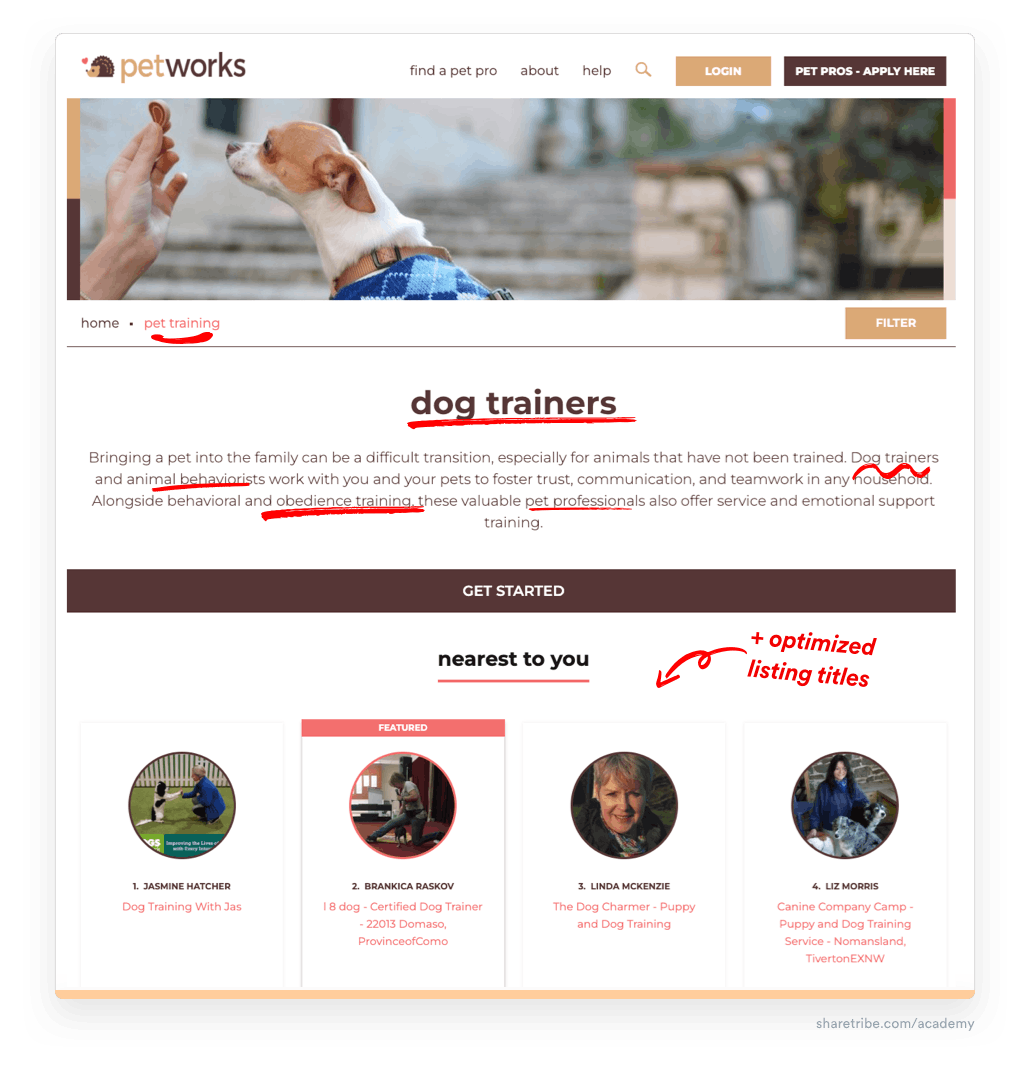
Third, encourage providers with listings in the category to use a nice mix of the main keyword and variants in their listing copy. Consider writing content to help providers to improve the SEO of their listings like Etsy and Eventbrite do.
Finally, be prepared to accept that optimizing category and listing pages is a process that likely takes constant learning and adjusting.
“You’re starting to learn the vocabulary of that category. And there are times when you might say, ‘you know what, I got it wrong the first time. I was not thinking about what actual users are typing,’” Michael says.
“And so you maybe want to change the category names, create new URLs, and redirect the old ones. It’s a lot of work. So as you’re spinning a new category, learn its vocabulary.”
Internal links are links between two pages within your site. I’ll discuss building links more thoroughly in the final article of this series. Here, I’ll focus on link anchor texts, which mean the words in your copy to which you add an internal link.
Making your link anchor texts descriptive of the content they’re linking to is important for SEO.
First of all, avoid non-descriptive link anchors like “this page”, “here”, or “click here”. At best, they’re a lost opportunity to write informative, keyword-rich link anchors. Furthermore, folks with visual impairment or blindness don’t get any information about the link destination from such anchor texts.
Secondly, using the right keywords in internal links strengthens your pages’ ability to rank for keywords. Google uses anchor texts to index and rank web pages.
In step 1, I discussed the importance of tying each page to a specific keyword or set of keywords. Follow the same protocol with internal links: use the main keyword of page A only in link anchors that lead to page A. Reserve page B’s keywords for page B links. And so on.
Thumbtack’s Questions and Answers pages are a great example of keyword-optimized link anchors. The screenshot below features Thumbtack’s answer to the question, “How much is carpet cleaning in Boston?”. The answer has two contextual internal links, one to another answer page and one to carpet cleaners in Boston.
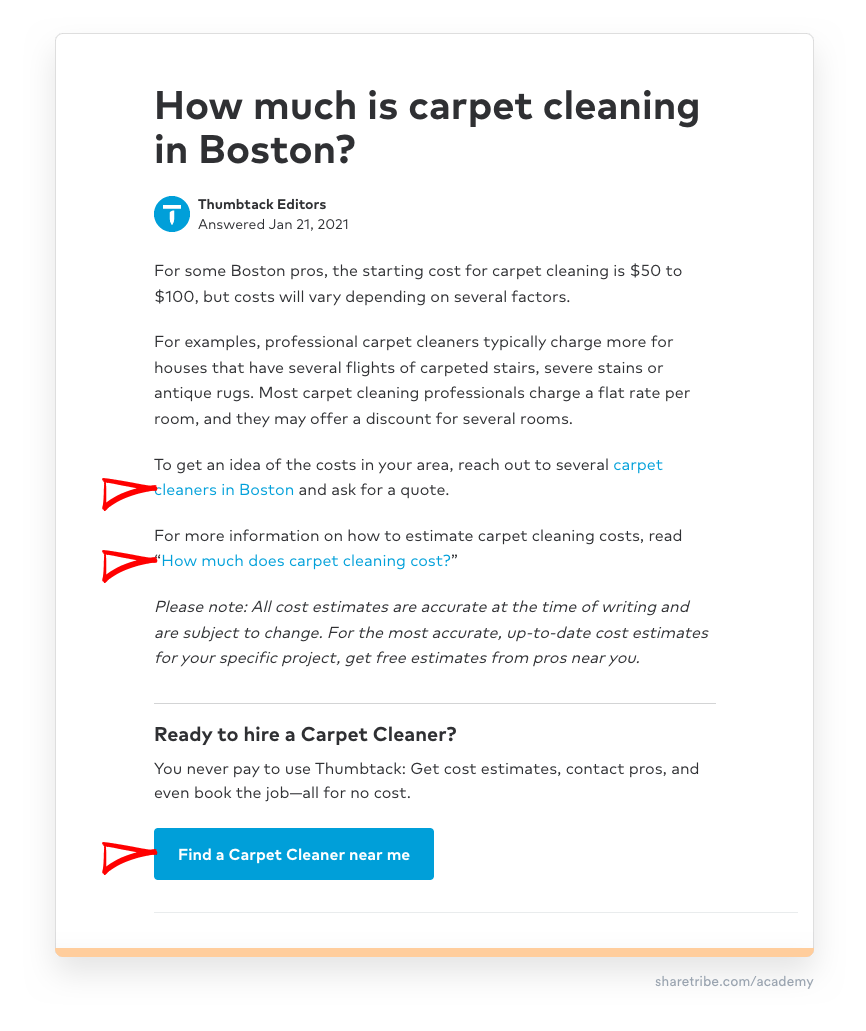
Both of the links use exact-match keywords in the link anchor texts (“carpet cleaners in Boston” and “How much does carpet cleaning cost?”) – as does the CTA button below the answer.
So, make sure you have internal links to your most important pages with descriptive, keyword-rich anchor texts.
But don’t overdo it! If all your internal link anchor texts to page A are 100% identical, Google may see them as spammy. Maintain variety by using variants of your main keywords and other related terms, too.
And most importantly, make sure all your internal links are relevant and will receive clicks from real users. Don’t add internal links just for their own sake. According to Google, using too many internal links on a page may dilute their value.
Has your keyword research led you to a group of relevant, competitive, commercial keywords? Consider creating a dedicated landing page to improve your chances of ranking.
This is what Airbnb did. They created a template for landing pages targeting location-specific queries: “Vacation rentals in [location]”. They then created a dedicated landing page for thousands of locations using the template. Here’s what the page for New York looks like.
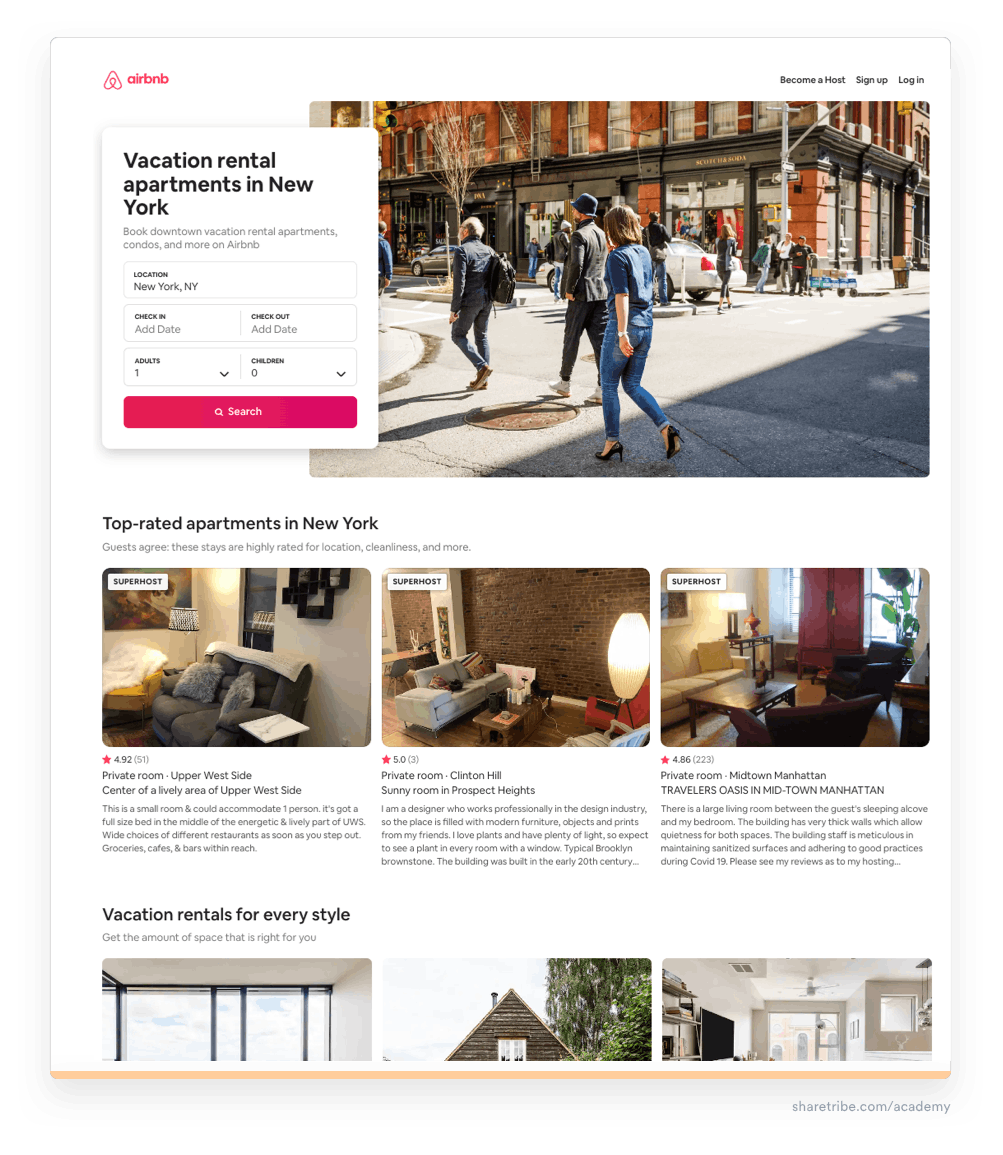
Note that this isn’t Airbnb’s marketplace category page for New York – it’s a page dedicated to bringing in and converting inbound traffic, with a search field in the header and featured top-rated listings in New York. The page also includes some more relevant content about popular tourist sites in NY.
According to an article by the Foundation team, thousands of landing pages like this generate Airbnb more than 2.8 million visits a month.
The approach looks very similar to Thumbtack’s pages targeting the “best [service providers] near me” queries. Again, they have multiple pages for different services, identical in layout but with unique copy targeting service-specific keywords. Here’s a landing page for dog-walking services.
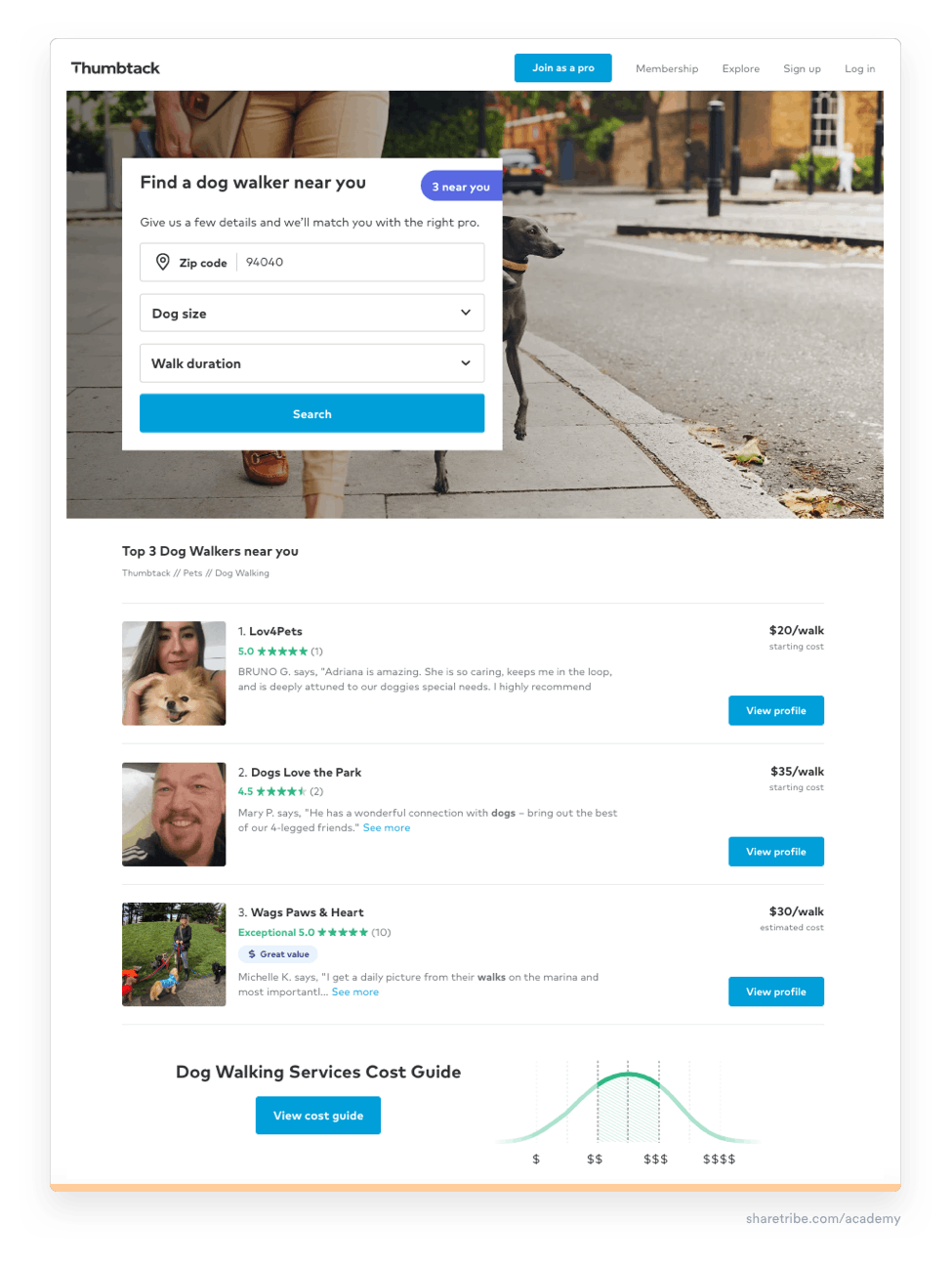
The opportunities for dedicated landing pages don’t stop with location-based searches. Eventbrite seems to be using a template-based approach for event categories (although they do rank for location-based searches with their country-based website’s category pages, too).
There’s a page for “online events” that gets some 2.2K monthly visits, according to Semrush. The same template looks to have been used to create pages for online seminars (1.9K visits), online speed dating (7K visits), and so on.
Interestingly, this approach seems to work even better for pages targeting the supply side. Eventbrite’s “Sell tickets” page gets 7.8K visits per month, the page for “Event registration software” gets 3.6K visits, the page for “online RSVP” gets 3K visits… All the pages look strikingly similar.

The benefit of the template-based approach is that it cuts down the time and cost of creating new pages. This lets the marketplaces target multiple smaller keywords easily, resulting in an “SEO moat” that builds their organic traffic and SERP dominance one keyword at a time.
Contrary to keyword-targeted landing pages, blog content is often informational.
Informational content is usually not as good at converting paying customers as commercial pages. At the same time, maintaining a consistent, high-quality content effort is time-consuming work.
Why do it if there’s no tangible ROI?
According to a State of Marketing report by Hubspot, more than 80% of marketers actively use content marketing. Why is writing and distributing content such an effective marketing strategy?
For starters, content that addresses your customers’ questions and problems builds visibility, authority, and credibility within your niche.
“If I were to start a marketplace today, I’d try to understand every question that’s being asked about my particular service and my particular product. I would write all of them down and then answer every single one of them,” Mike van der Heijden says.
“What you should essentially be doing from day one is show the search engines and users that you’re an expert on this particular topic.”
Informational content also lets you build an audience: create a mailing list and engage with users through newsletters about new articles, distribute and discuss articles over social media channels, and find amplifiers who talk about your content with others.
Petworks also uses content to leverage its community of pet professionals by inviting them to guest-post on the site.
“We share the article with our social media community, and the pet pro might want to share it also,” Michael says.
“It’s a win-win because the pet pro gains visibility and a chance to share their expertise, and hopefully it drives some traffic back to their main website.”
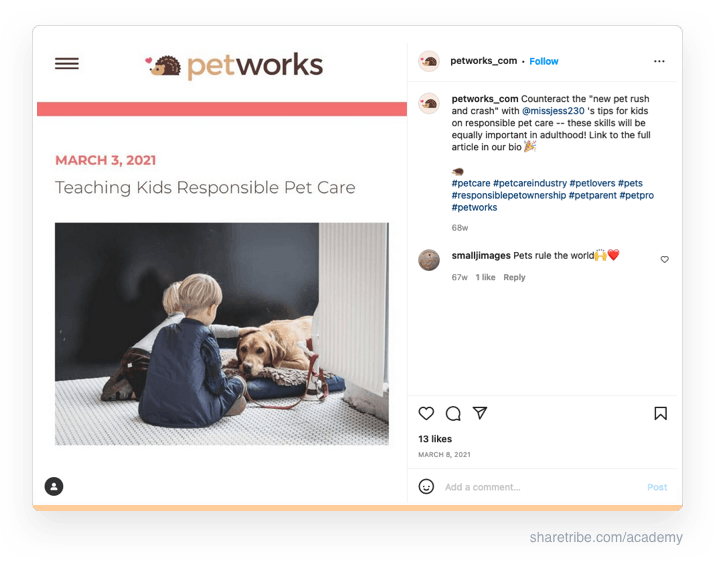
Blog content is also great at building editorial backlinks, Gregory Edwards notes.
“Your article content is far more likely to far more likely to be linked to than any other area of your marketplace, your product or category pages, for example.”
Finally, engaging content can keep people returning to your site more often and spending more time on it, which is an SEO quality signal.
In a nutshell: a content marketing initiative is the backbone of SEO and worth considering when you’re ready to commit to it.
For marketplaces, the two-sided nature of the audience can present an opportunity and a challenge. On the one hand, you have two audiences that are likely interested in very different types of content.
On the other, both groups probably crave content you’re uniquely qualified to offer.
To create content for customers, you can benefit from your community of providers as Michael Caldwell did with Petworks. Leverage your sellers and build their visibility by channeling their expertise through your site.
Thumbtack also does this well. Their Questions and Answers pages target dozens of questions people have (and, likely, google) around home repairs and improvements. On the answers page, Thumbtack attributes the information to its network of professionals – and links to a commercial page with a call to action.
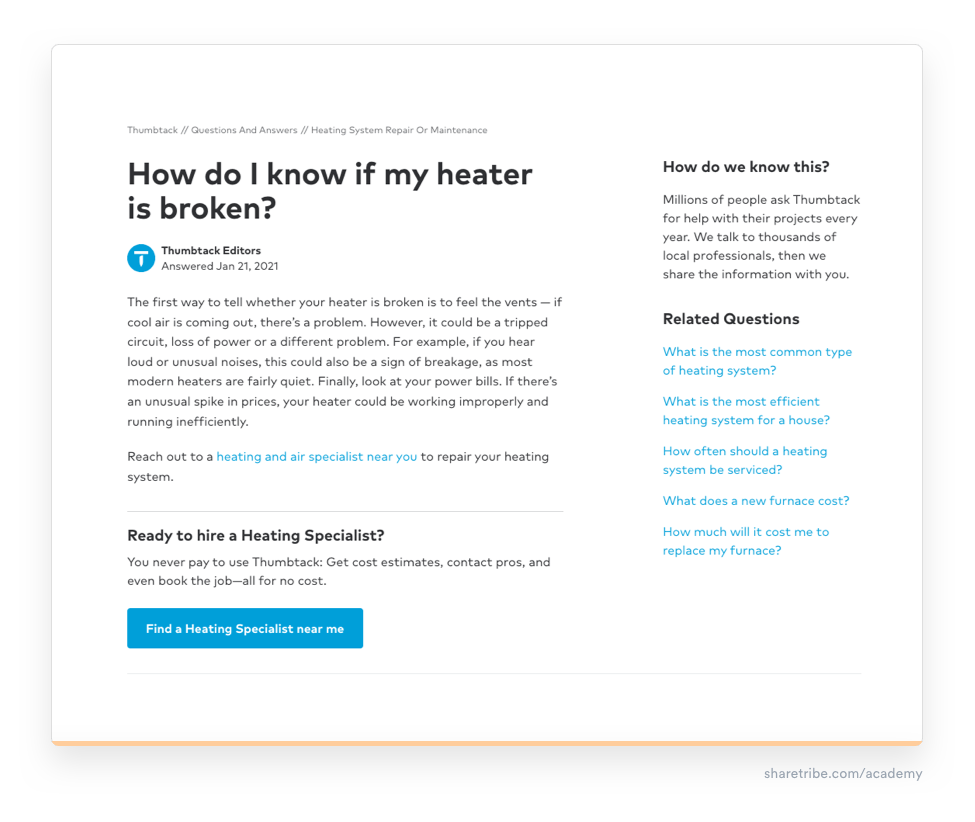
Thumbtack also offers project guides and cost estimates. This type of content helps customers make informed decisions on hiring on Thumbtack and increases their trust in the platform. At the same time, it may improve the providers’ experience by sending them better-informed customers.
For your providers, you can write content that shows you’re committed to helping them succeed. Marketplaces like Airbnb, Eventbrite, Thumbtack, and Zillow have extensive resource centers that discuss both what it takes to succeed on the platform. They also have content on general topics that may interest hosts, event organizers, service providers, or home sellers, respectively.
Maintaining content initiatives for both groups is a big investment that takes time to bring a return. Still, the authority, audience, and traffic it builds is an asset that isn’t easy for your competitors to duplicate.
Anything your audience is interested in! Consider, for example:
- How-to articles, guides, or ebooks related to your niche. Example for customers: Thumbtack’s How to Landscape Your Yard. Example for providers: Eventbrite’s eBook Guide to Event Sponsorship
- Stories from your user community. Example: DoorDash’s How Greenwood Shop Grows Local Retail Sales with DoorDash
- Opinionated articles that make a statement your audience will feel strongly about. Example: Petworks’ Dumb Dogs Don’t Have Problems article
- Seasonal content related to important events or times of the year. Example: Etsy’s Valentine�’s Day Gifts for All the Loves of Your Life (Including Yourself)
- Articles about insights from your platform. Example: Doordash’s The 100 Most Loved Restaurants on Doordash Revealed
- Pieces shedding light on industry trends. Example: OpenTable’s What Diners Want: How Dining is Changing in 2022
- Original research. Example: Thumbtack’s famous Small Business Friendliness Survey
- Helpful tools. Example: Zillow’s Mortgage calculator
undefined
Remember that each piece of content you create is an asset you can repurpose and redistribute indefinitely. An article you wrote could also become:
- A YouTube video
- A podcast episode
- A Twitter thread
- A LinkedIn post
- A Quora reply
- An infographic
- And so on.
“How-to style videos, in particular, tend to do quite well. Creating partnering video for your article content will help you target more users, but also gives you good visibility in the rich search results as well,” Gregory Edwards says.
Though content marketing is connected to SEO, it’s a marketing tactic in its own right that would deserve an article series of its own.
For further reading, I suggest turning to expert sources. I’ve found lots of value in content by the content marketing agency Animalz and the B2B content marketing agency Foundation (and the tweets from Foundation’s founder Ross Simmonds), and anything posted by Sparktoro, its founder Rand Fishkin, and VP of Marketing Amanda Natividad.
Using keywords in meta tags, internal links, and category titles is an SEO best practice, so optimizing them on your marketplace is a solid investment.
But keyword use is about much more than tweaking page titles. As Michael Caldwell, Mike van der Heijden, and Gregory Edwards point out, it’s about maintaining an SEO mindset in everything you do. You need to show search engines and your audience alike that you are the number one expert in your niche.
Content marketing doesn’t necessarily require a big marketing budget, but it certainly isn’t free. It takes hours and hours of time and effort, which are likely to pay off only months later. But as examples from successful marketplaces show, the returns can be significant. SEO and content marketing can help you build defensible, long-term traffic streams, foster trust and engagement within your user community, and build quality editorial links from reliable sources.
The next and final article of this marketplace SEO series discusses why backlinks are so important – and shares some strategies for building quality backlinks.
You might also like...

Marketing & growth
How to find the best marketplace growth strategies
Choosing the early-stage marketing mix for your marketplace.
by Juho Makkonen

Marketing & growth
Growing with content - An interview with Simon Powell
The founder of TransferTravel reveals how creating content helped them build supply and awareness about their marketplace, up to 30,000 visitors per month, without spending anything on ads.
by Juho Makkonen

Marketing & growth
Platform technology
Marketplace SEO: the complete guide
Get a comprehensive introduction to the world of SEO, tailored specifically to online marketplaces.
by Mira Muurinen

